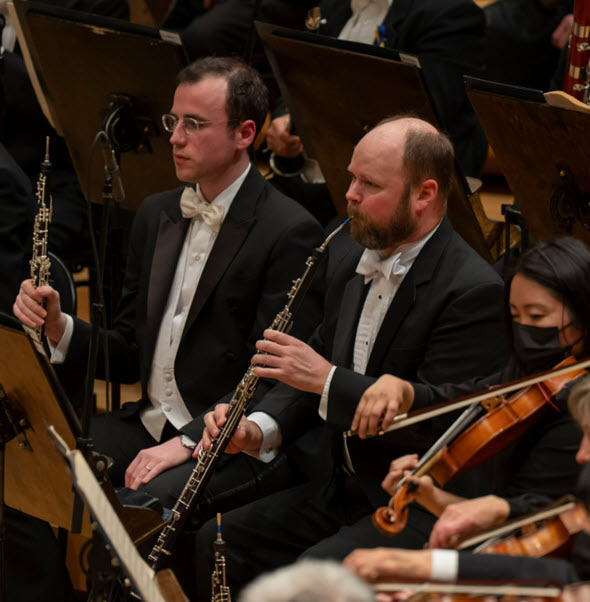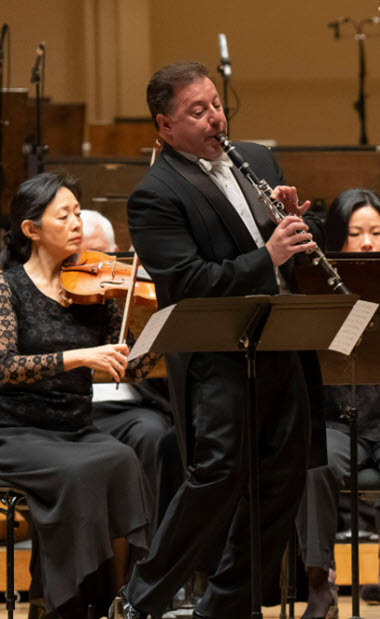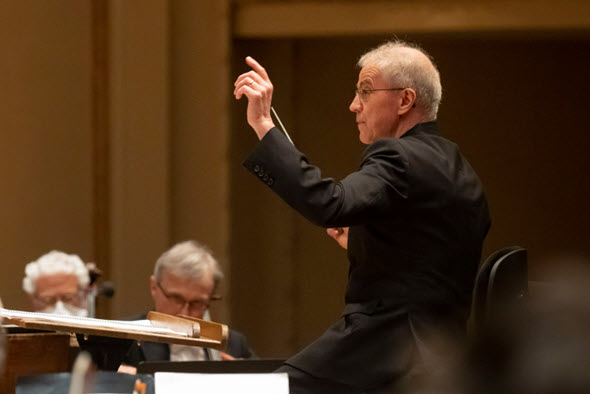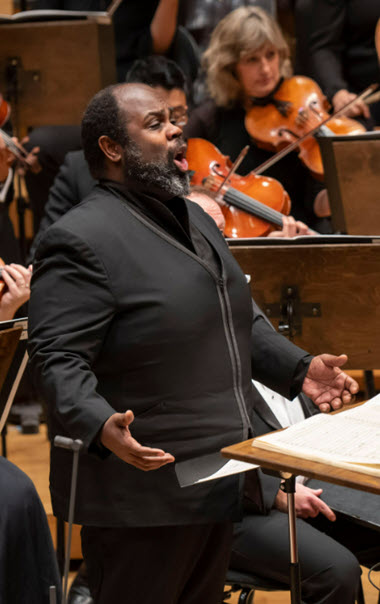As arts groups aim at winning audience back, CSO hits the target in back-to-back programs
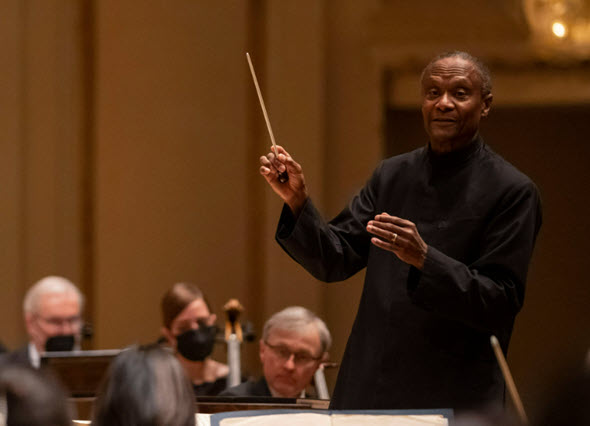
Conductor Thomas Wilkins led a CSO performance of Dvořák’s Symphony “From the New World.” (Photos by Todd Rosenberg)
Commentary: The Chicago Symphony Orchestra twice displayed how it has adapted in spirit and quality to a post-pandemic world.
By Lawrence B. Johnson
As performing arts organizations find their way back to post-pandemic life and relevance, the former condition may depend heavily on the latter. The world, certainly the United States, is a different place from what it was before March 2020, when the entire cultural community went silent – when officials at the Chicago Symphony Orchestra met patrons at the door to inform them that the communal enjoyment of music was summarily suspended until further notice. Who could have imagined that three years later – three years! – presenters would still be gauging how to reengage the public?
And who could have foreseen how not only the pandemic but events in our country would contribute to such a profound and irrevocable shift in the meaning and content – or to borrow Hamlet’s phrase, the form and pressure – of the performing arts?
The emergent paradigm of inclusion, this new arts-wide acknowledgement of stage and concert hall as Everyperson’s forum and welcoming agora for all who wish to assemble there, was on manifest display in recent Chicago Symphony performances at Orchestra Hall. The repertoire showcased its fresh profile in brave new works or just unusual music by a broad range of composers, served up by a wide spectrum of artists. It was a mix highlighted by the CSO subscription debut March 23-26 of an elegant veteran, the African American conductor Thomas Wilkins.
Wilkins was not new to me. I knew him and his seriousness, his authority and his optimism years ago when I was the music critic at The Detroit News and he was associate conductor of the Detroit Symphony Orchestra. That was before he became music director of the Omaha Symphony Orchestra, and then principal conductor of the Hollywood Bowl Orchestra as well as family and youth concerts conductor of the Boston Symphony Orchestra.
While Wilkins, now 66 years old, led the CSO in a program of imaginative parts, I can’t help noting first the most familiar work on offer, which also provided the most impressive example of his command of the art of conducting: Dvořák’s Symphony No. 9 in E minor (“From the New World”).
Wilkins may be as undemonstrative as conductors come, but in his understated fashion he drew a blazing performance from an orchestra that seemed to revel in the sheer sonic possibilities of Dvořák’s beloved score. Wilkins’ tempos were well considered, his rhythmic pulse at once flexible and infectious and his overall shaping of the work as lyrical as it was dynamic. Amid the cascading brasses and sparkling woodwinds, it was electric fun – punctuated by an eloquent turn through the slow movement, which turned the spotlight on the liquid, languorous English horn of Scott Hostetler.
Not far removed in time or Romantic spirit, but virtually unknown to the music-loving world, was the “Hiawatha” ballet suite by the Black English composer Samuel Coleridge-Taylor (1875-1912). The CSO had never before played this 15-minute work written for piano in the last year of Coleridge-Taylor’s life and orchestrated in 1919 by Percy Fletcher. Movements of pervasive, appealing gentleness alternate with episodes of impulsive, driving dances. Wilkins and the CSO offered an affectionate portrait of the four-movement suite – essentially a series of tableaux by a British composer conjuring Longfellow’s impressions of Native American culture.
Rounding off Wilkins’ program was the comparative novelty of Copland’s Clarinet Concerto. Written in 1947 for Benny Goodman, this terse, two-movement essay packs a lot of caressing song and hot sauce into its 17-minute duration. CSO principal clarinet Stephen Williamson charged Copland’s suave and and piquant music with impeccable finesse matched by all the stylish flair – and technical means – required for the work’s last jazzy riffs.
The previous week’s concerts, led by Osmo Vänskä, the longtime music director of the Minnesota Orchestra, likewise juxtaposed music of boundless popularity, Orff’s existential cantata “Carmina Burana,” with the fresh seasonings of works likely new to most listeners. The first of these spotlighted the CSO’s current composer in residence, Jessie Montgomery, whose “Banner” unfolded in a stream of jagged snippets from “The Star-Spangled Banner,” as if perceived through the fractured prism of modern America. It’s a witty, smartly crafted little essay that the CSO tossed off not in the dawn’s early light but in the telling fullness of midday.
Somehow, 1972 doesn’t seem like 50 years ago, but here we are. In a timeless way, the brash vitality of Finnish composer Einojuhani Rautavaara’s “Cantus arcticus (Concerto for Birds and Orchestra),” shrinks that widening gap. One of Finland’s greatest composers, Rautavaara, who died in 2016 at age 87, was in mid-life when he wrote his disarming “Arctic song” for orchestra with an overlay of recorded bird sounds. It’s a sort of avian tone poem in three movements titled “The Bog,” “Melancholy” and “Swans Migrating.” And while pauses by the orchestra delineate the movements, the birdsong never ceases. There’s a palpable vestige of Sibelius in the earthy, bright and colorful orchestral writing. But in the end, as in the gaps, it’s the irrepressible birdsong that fills the imagination’s sky.
I suspect that when patrons who attended one of the CSO-Vänskä concerts look back on this season, among their fondest recollections will be “Carmina Burana” – a performance as vibrant and dark, as sublime and soused as any I can remember. Basically, Orff’s cycle of 24 settings of medieval poems deals with life’s two principal concerns: love and drink. Everything else just falls under one of those headings. Moreover, these witty and passionate and insistent songs keep telling us, we can’t control anything anyway: We are all Fortune’s fools. That, in a nutshell, is “Carmina Burana’s” hourlong exegesis for large orchestra (including two pianos), chorus, children’s chorus, soprano, baritone and countertenor.
Vänskä presided over a utterly irresistible performance, and a deceptively virtuosic one by the Chicago Symphony Chorus, whose incisive rhythmic precision, crisp diction, fine pianissimos and explosive energy added up to one grand sensation.
The young choristers of Uniting Voices Chicago were nothing short of angelic – a needed antidote to the hilarious, deep-cellar tipsiness (amid superb singing) that baritone Hugh Russell brought to his songful inhabitation of a very drunk monk. Countertenor Reginald Mobley added a delicious first-hand (or -wing) account of what it’s like to be roasted on a spit and devoured. And soprano Joélle Harvey capped all and everything with her soaring top notes in the court of love.
The Chicago Symphony bound the parts together with a performance that may have been conspicuous for its hammer-and-tong potency, but which was indeed no less spectacular at its most quiescent. Vänskä led this marvelous pageant like some invisible puppeteer, perhaps unobserved but quite indispensable.

